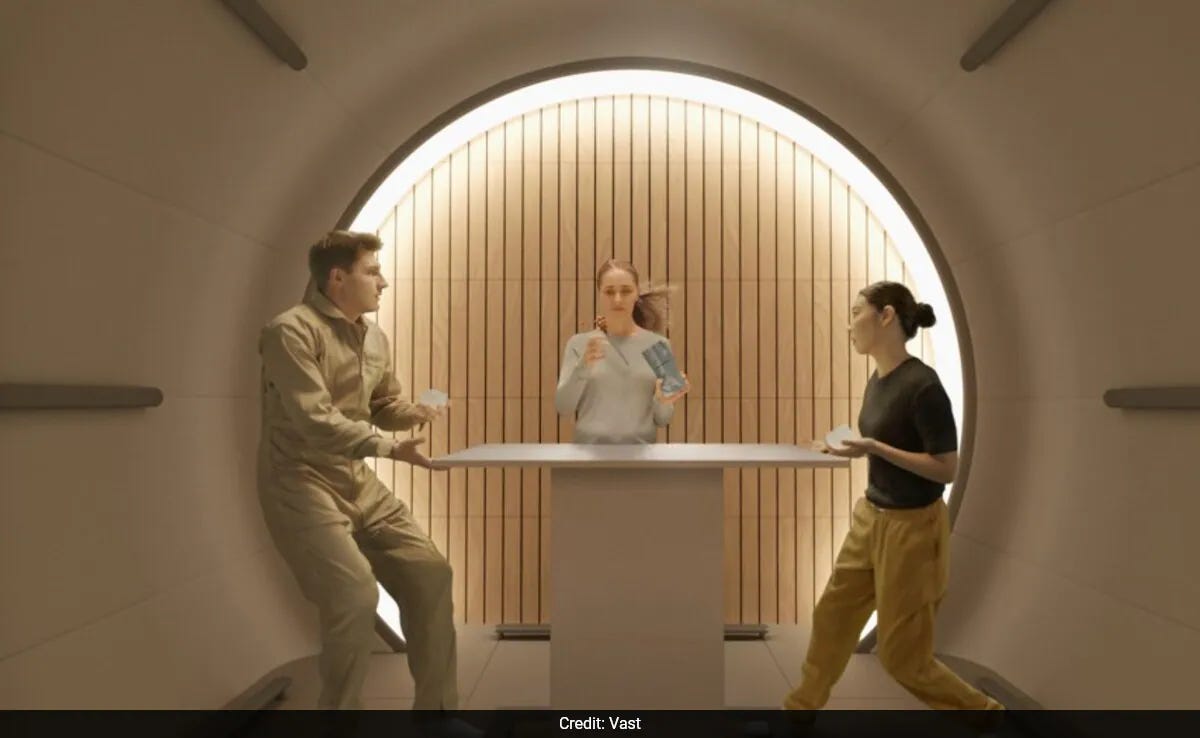Haven-1: Private Space Exploration
The Future of Commercial Space Habitats
Hello friends, happy to inform you the project on Aircraft Deck playing cards got fully funded in just 5 hours of launch on Kickstarter. Thank you everyone for your support. If you are interested in getting one for you please check the project here.
Now, back to today’s article.
Recently Haven-1, the world's first commercial space station was unvieled. It can accommodate four astronauts in cosy rooms, outdoing the ISS in comfort. Each room includes storage, vanity, and a specially designed queen-sized bed for better sleep.
Full video : VAST's Haven-1
Additional features:
1.1m Observation Window Dome for stunning views of Earth
Patent-Pending Sleep System designed for optimal rest in zero gravity
Onboard Fitness System to improve cardiovascular and bone health
Warm, welcoming Interiors with natural materials, including maple wood veneer
Let’s dive into the details
The allure of space has captivated humanity for centuries. While governments have led the charge in space exploration, the private sector is increasingly making its mark, pushing the boundaries of innovation and offering new possibilities. One such endeavor is Haven-1, a proposed private space station that promises to revolutionize our understanding of space and its potential.
The goal of Haven-1 is to serve as a commercial outpost in low Earth orbit (LEO), offering both a research platform and a habitat for astronauts, scientists, and potentially even space tourists. Designed to complement existing government-operated space stations like the International Space Station (ISS), Haven-1 represents a significant leap toward a future where private space stations will provide the bulk of human infrastructure in orbit.
This article delves into the concept of Haven-1, examines the need for private space stations, explores how it differs from current stations, analyzes the cutting-edge technologies involved, and considers what the future holds for this groundbreaking project.
The Need for Private Space Stations
The International Space Station (ISS) has been a cornerstone of space exploration for decades, serving as a platform for scientific research and technological advancement. However, as the ISS nears the end of its operational life, the need for a new space station becomes increasingly apparent. Private space stations offer several advantages over their government-funded counterparts:
Commercial Viability: Private space stations can generate revenue through various means, including scientific research, tourism, and manufacturing. This economic model can ensure long-term sustainability and investment in space exploration.
Flexibility and Innovation: Private companies have more flexibility to adapt to changing market conditions and pursue innovative projects. This can lead to rapid advancements in space technology and exploration.
International Cooperation: Private space stations can foster international collaboration and cooperation, breaking down political barriers and promoting peaceful exploration of the cosmos.
How Haven-1 Differs from Current Space Stations
Smaller, Flexible Design: Unlike the massive International Space Station, which was built through international cooperation over decades, Haven-1 will be more compact and specialized. Vast's design is focused on providing a modular, scalable habitat that can be expanded over time. Its smaller size makes it easier and faster to construct, launch, and maintain, allowing for a quicker turnaround in deployment.
Commercial and Private Focus: Haven-1 will be the first space station primarily designed with commercial purposes in mind. While the ISS is largely a platform for scientific research, Haven-1 will cater to a broader range of activities, including space tourism, industrial manufacturing in microgravity, and private research experiments. By allowing non-governmental organizations and individuals to access the station, Haven-1 will significantly broaden the scope of who can participate in space activities
Partnership with SpaceX: A key differentiator for Haven-1 is its collaboration with SpaceX, the private space transportation company. Vast has announced that Haven-1 will be launched aboard a SpaceX Falcon 9 rocket, with SpaceX’s Dragon capsule acting as the vehicle for transporting astronauts and cargo to the station. This partnership reduces costs and leverages SpaceX's reusable rocket technology, which has already revolutionized space travel by dramatically lowering the cost of launching payloads into orbit.
Technologies Involved in Haven-1
Modular Space Habitat: Vast's vision for Haven-1 is rooted in a modular architecture, meaning that the station will be constructed from a series of interconnected units. This approach has several advantages. First, it allows for flexibility in expanding the station over time, as new modules can be added to increase its capacity. Second, it allows different modules to be tailored to specific purposes. For example, one module might serve as a laboratory for scientific research, while another might be configured as living quarters for space tourists.
This modular approach also means that future upgrades to the station can be implemented without requiring a complete overhaul of the existing infrastructure. As new technologies become available, they can be integrated into the station as additional modules.
Life Support Systems: To support human life in space, Haven-1 will need advanced life support systems that ensure a constant supply of oxygen, water, and food, while effectively managing waste. These systems will be critical for both short-term missions and longer stays in orbit. Haven-1 is expected to feature a closed-loop life support system, which will recycle air and water to minimize the need for resupply missions from Earth. This type of system is essential for future space habitats, particularly as humanity looks toward more distant destinations like Mars.
Microgravity Research Capabilities: Haven-1 will be a platform for research in microgravity, offering a unique environment for experiments that cannot be conducted on Earth. For example, pharmaceutical companies might use the station to study the behavior of proteins in microgravity, leading to the development of new drugs. Similarly, manufacturing companies may use the station to produce advanced materials that can only be made in space.
Advanced Radiation Shielding: One of the biggest challenges of long-term space habitation is protecting astronauts from cosmic radiation. The ISS is protected to some extent by Earth's magnetic field, but a station in low Earth orbit, such as Haven-1, will still need enhanced radiation shielding. Vast is likely to incorporate cutting-edge radiation shielding materials and design techniques to minimize the exposure astronauts face during their time aboard the station.
Autonomous Station Operation: Another key technological innovation in Haven-1 will be its autonomous operation systems. While the ISS requires constant oversight and human intervention for many of its systems, Haven-1 will be designed with the ability to function autonomously for extended periods. This feature is crucial for making the station economically viable, as it reduces the need for constant human presence and allows the station to operate with a skeleton crew or even no crew at all for certain periods.
Future and Way Ahead
The development of Haven-1 represents a significant milestone in private space exploration. If successful, it could pave the way for a new era of human activity in space, with private companies playing a leading role. The future of Haven-1 and similar projects is promising, with the potential to unlock the vast resources of space and advance our understanding of the universe.
As Haven-1 progresses, it will be crucial to address challenges such as funding, technological hurdles, and international cooperation. However, with the right approach and the support of governments, private companies, and the public, Haven-1 could become a symbol of human ingenuity and a testament to our enduring desire to explore the cosmos.





